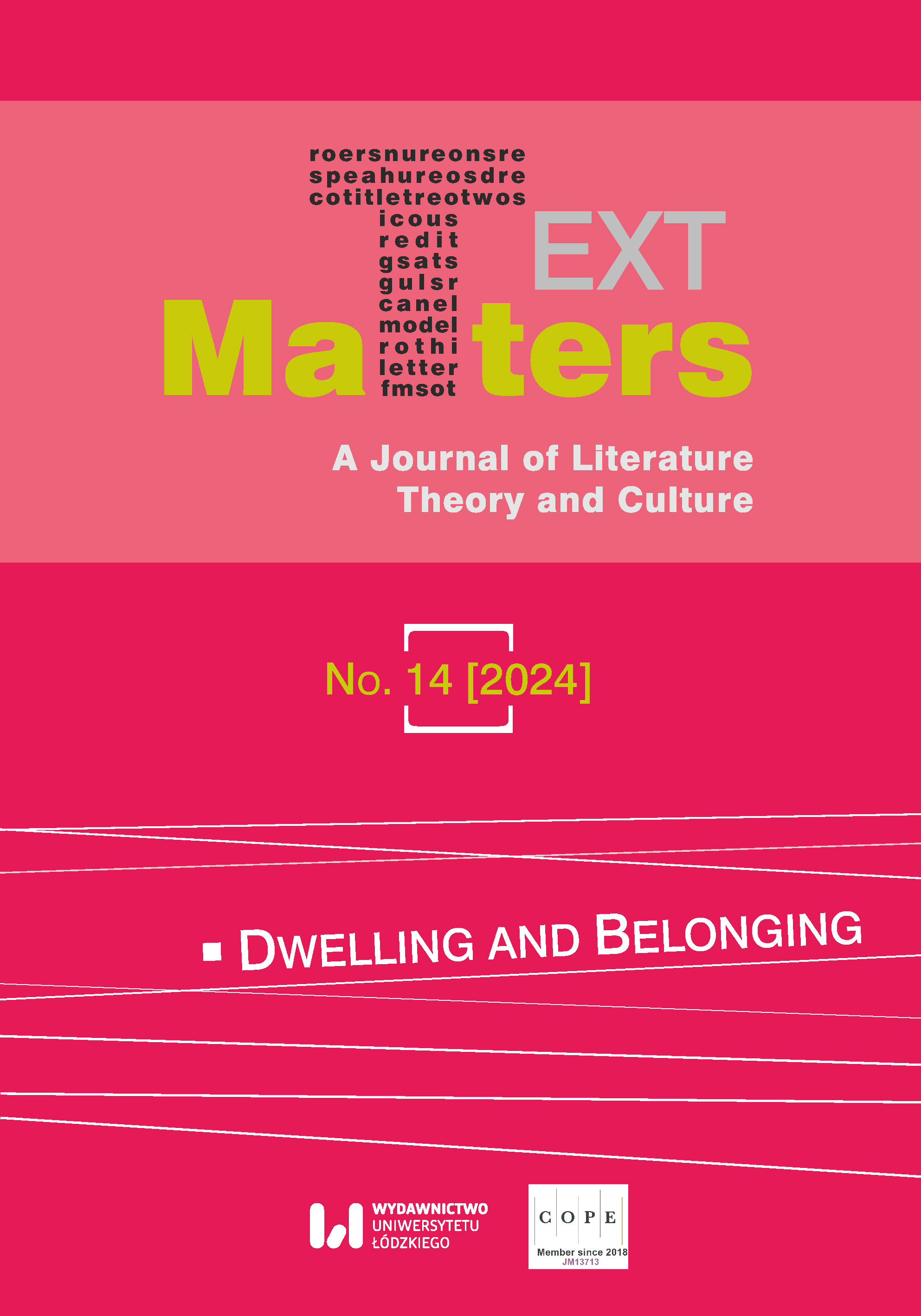Building Liveable Futures: Dwelling as Collaborative Survival After Climate Change
DOI:
https://doi.org/10.18778/2083-2931.14.11Keywords:
dwelling, speculative design, collaborative survival, climate change, more-than-human, the AnthropoceneAbstract
Taking a cue from Tim Ingold’s post-humanist reflection on building and dwelling as more-than-human practices, the article aims to revisit dwelling as a strategy of “collaborative survival” (Tsing) in the context of the ongoing climate emergency. Drawing on the findings of more-than-human geography and environmental (post)humanities, the article scrutinizes three examples of contemporary speculative projects at the intersection of architecture, design and performative arts that imagine different strategies of building with and for more-than-humans as a climate change adaptation strategy. Firstly, the installation Refuge for Resurgence (2021) by the Los Angeles-based design studio Superflux, a banquet table designed for humans and various species of animals, is analyzed in order to interrogate the relation between dwelling and multispecies interdependence. Secondly, the article scrutinizes the multimedia project Pending Xenophora (2020–22) by Mari Bastashevski, an architecture created with an endangered species of snail, to show more-than-human care (Puig de la Bellacasa) as key to surviving climate change. Finally, the article looks into the project The Anthropocene Museum (2020–ongoing) by the Kenyan collective Cave_bureau to unravel decolonial aspects of dwelling as collaborative survival.
Downloads
References
Bakke, Monika. “Introduction: The Sheltering Sky of the City.” Refugia. The Survival of Urban Transspecies Communities, edited by Monika Bakke, Wydawnictwo Naukowe UAM, 2021, pp. 17–23.
Google Scholar
Bastashevski, Mari. Pending Xenophora. Mari Bastashevski, 2020–22, https://www.maribastashevski.com/pending-xenophora accessed 10 Sept. 2023.
Google Scholar
Bastashevski, Mari. “Unwhorl.” Vimeo, https://vimeo.com/546195072 accessed 10 Sept. 2023.
Google Scholar
Cave_bureau. Anthropocene Museum 1.0–10.0. Cave_bureau, https://www.cave.co.ke/cave-canon accessed 20 Jan. 2024.
Google Scholar
Costanza, Robert, et al. “Twenty Years of Ecosystem Services: How Far Have We Come and How Far Do We Still Need to Go?” Ecosystem Services, vol. 28, 2017, pp. 1–16. https://doi.org/10.1016/j.ecoser.2017.09.008
Google Scholar
DOI: https://doi.org/10.1016/j.ecoser.2017.09.008
Crutzen, Paul, and Eugene Stoermer. “The Anthropocene.” Global Change Newsletter, vol. 41, 2000, pp. 17–18.
Google Scholar
Escobar, Arturo. Designs for the Pluriverse. Radical Interdependence, Autonomy, and the Making of Worlds. Duke UP, 2016.
Google Scholar
European Commission. “Nature-Based Solutions & Re-Naturing Cities” (full version). Publications Office, 2015, https://data.europa.eu/doi/10.2777/479582 accessed 20 Sept. 2023.
Google Scholar
Ferdinand, Malcom. Decolonial Ecology. Thinking from the Caribbean World. Polity, 2021.
Google Scholar
Haraway, Donna J. Staying with the Trouble. Making Kin in the Chthulucene. Duke UP, 2016. https://doi.org/10.2307/j.ctv11cw25q
Google Scholar
DOI: https://doi.org/10.2307/j.ctv11cw25q
Ingold, Tim. The Perception of the Environment. Essays on Livelihood, Dwelling and Skill. Taylor and Francis, 2000.
Google Scholar
Jacque, Andrés, Marina Otero Verzier, and Lucia Pietroiusti. Editorial. More-Than-Human, edited by Andrés Jacque, Marina Otero Verzier and Lucia Pietroiusti, Het Nieuwe Instituut, 2017, pp. 6–9.
Google Scholar
Karanja, Kabage, and Stella Mutegi. “In Practice: Cave Bureau on a Museum for the Anthropocene.” The Architectural Review, 15 Apr. 2021, https://www.architectural-review.com/essays/in-practice/in-practice-cave-bureau-on-a-museum-for-the-anthropocene accessed 20 Sept. 2023.
Google Scholar
“Nature-Based Solutions.” European Commission, https://research-and-innovation.ec.europa.eu/research-area/environment/nature-based-solutions_en accessed 20 Sept. 2023.
Google Scholar
Neyrat, Frédéric. The Unconstructible Earth. An Ecology of Separation. Fordham UP, 2019. https://doi.org/10.1515/9780823282609
Google Scholar
DOI: https://doi.org/10.1515/9780823282609
Puig de la Bellacasa, Maria. Matters of Care. Speculative Ethics in More than Human Worlds. U of Minnesota P, 2017. https://doi.org/10.1017/S2753906700002096
Google Scholar
DOI: https://doi.org/10.1017/S2753906700002096
Santer, Steve. “The Difficulty of Leaving Human Dominance in More-than-Human Contexts.” Medium, 18 Sept. 2021, https://medium.com/future-human-by-design-philosophy-of-design/the-difficulty-of-leaving-human-dominance-in-more-than-human-contexts-ffefe40bfde accessed 19 Jan. 2024.
Google Scholar
Sarkis, Hashim. “Statement.” La Biennale Di Venezia, 2021, https://www.labiennale.org/en/architecture/2021/statement-hashim-sarkis accessed 20 Sept. 2023.
Google Scholar
Shah, Devanshi. “STIRring Together: ‘Refuge for Resurgence’ Offers Glimpse into a New Way of Living.” STIRworld, 9 May 2021, https://www.stirworld.com/see-features-stirring-together-refuge-for-resurgence-offers-glimpse-into-a-new-way-of-living accessed 20 Sept. 2023.
Google Scholar
Stengers, Isabelle, and Didier Debaise. Gestes spéculatifs. Les presses du réel, 2015.
Google Scholar
Superflux. Refuge for Resurgence. 2021. Biennale Architettura, La Biennale Di Venezia.
Google Scholar
Tsing, Anna. “A Threat to Holocene Resurgence is a Threat to Liveability.” The Anthropology of Sustainability: Beyond Development and Progress, edited by Marc Brightman and Jerome Lewis, Palgrave Macmillan, 2017, pp. 51–65. https://doi.org/10.1057/978-1-137-56636-2_3
Google Scholar
DOI: https://doi.org/10.1057/978-1-137-56636-2_3
Tsing, Anna. The Mushroom at the End of the World. On the Possibility of Life in Capitalist Ruins. Princeton UP, 2015. https://doi.org/10.1515/9781400873548
Google Scholar
DOI: https://doi.org/10.1515/9781400873548
Van Dooren, Thom. A World in a Shell: Snail Stories for a Time of Extinctions, MIT P, 2022. https://doi.org/10.7551/mitpress/14579.001.0001
Google Scholar
DOI: https://doi.org/10.7551/mitpress/14579.001.0001
Wakkary, Ron. Things We Could Design. For More Than Human-Centered Worlds. MIT P, 2021. https://doi.org/10.7551/mitpress/13649.001.0001
Google Scholar
DOI: https://doi.org/10.7551/mitpress/13649.001.0001
Yusoff, Kathryn. “Broken Earth & Built Earths: Architectures at an Inhuman Impasse.” YouTube, uploaded by Yale School of Architecture, 7 June 2023, https://www.youtube.com/watch?v=pE7N8Xf1eXk accessed 10 Sept. 2023.
Google Scholar
Downloads
Published
Versions
- 2024-11-28 (2)
- 2024-11-28 (1)
How to Cite
Issue
Section
License

This work is licensed under a Creative Commons Attribution-NonCommercial-NoDerivatives 4.0 International License.
Funding data
-
Narodowe Centrum Nauki
Grant numbers DEC-2021/05/X/HS2/01239













